Common Backyard Birds in Iowa (With Pictures)
Last Updated on
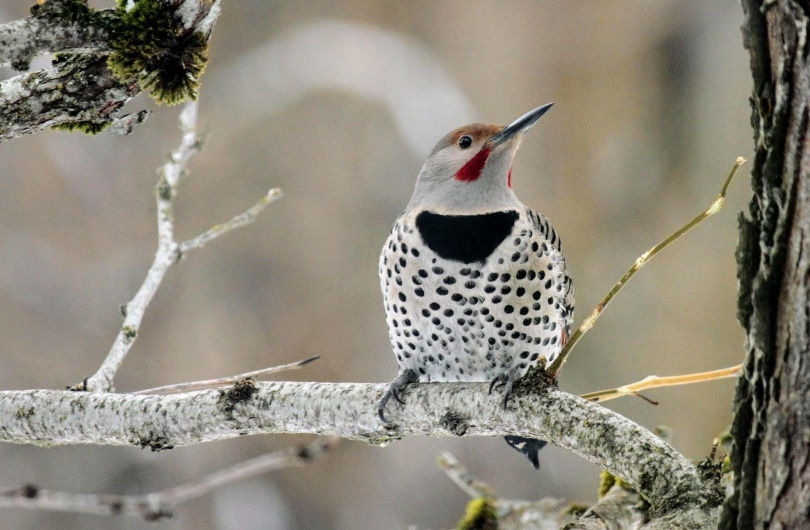
Iowa is a Midwestern state that’s known for its beautiful trails, expansive bluffs, and beautiful lakes. Located right on the Mississippi River, you’ll find an interesting mix of wildlife and beautiful scenery. You’ll also find a number of different backyard birds that are native to the US as well as other countries.
Iowa’s moderate temperatures and woody areas make it a good place to nest and live in the warm and winter months. So, if you’re new to birdwatching and happen to see different types of birds in your backyard, we’ve got the perfect list for you. In this article, we’re going to go over some of the most popular backyard birds found in the state of Iowa.

Common Backyard Birds in Iowa
1. Black-Capped Chickadee
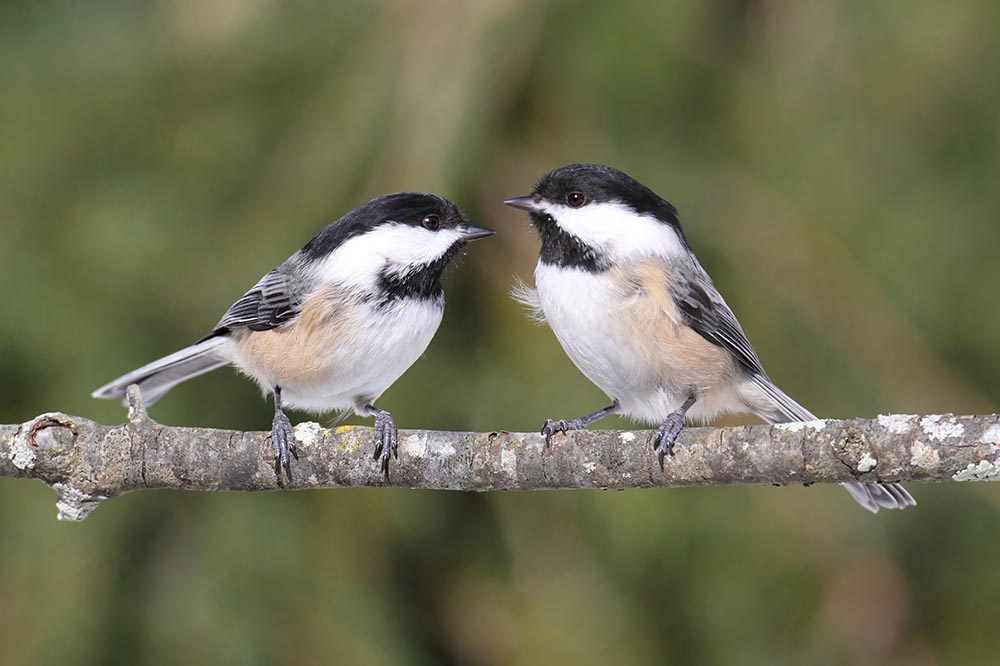
| Scientific Name: | Poecile atricapillus |
| Weight: | 3-0.5 oz |
These small birds have wide round bodies that are pretty easy to recognize. Overall, they appear a gray-blackish color, but their wings and back are darker. Their underbellies are light gray and really fluffy. They have solid white cheeks and have a funny strut when they walk. They love feeding on sunflower seeds, nuts, and small insects.
2. Song Sparrow
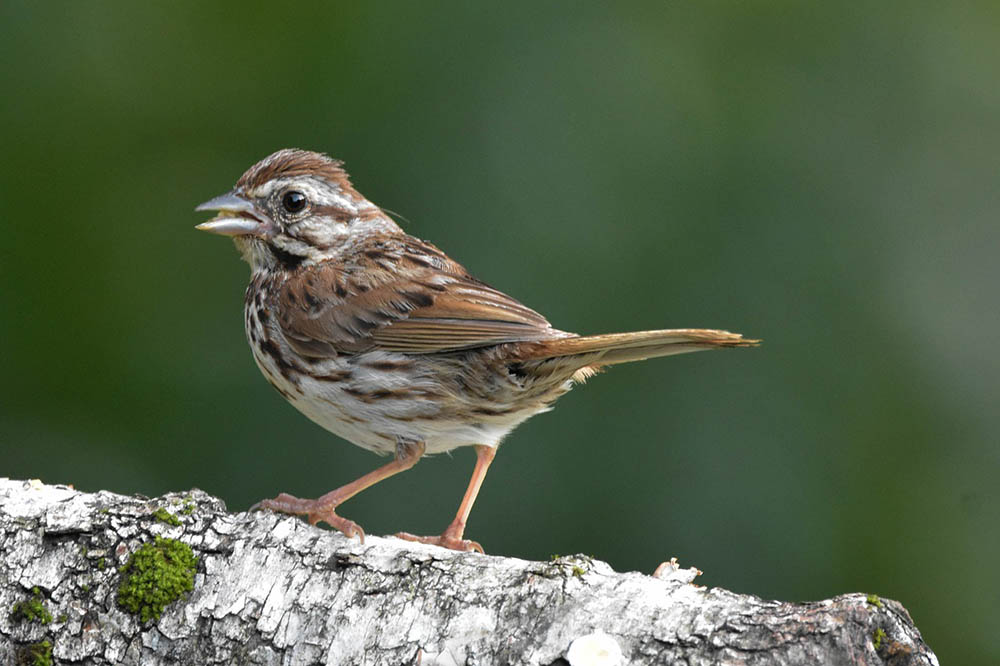
| Scientific Name: | Melospiza melodia |
| Weight: | 4-1.9 oz |
These beautiful sparrows are common to Iowa and different Midwest areas in the United States. They often migrate from region to region and are easily spotted by their brown back and wings. Song Sparrows have dark brown streaks on their bellies and chest with a noticeable brown spot in the center–which helps to identify them. These birds are staunch defenders of their nesting territories and they love to eat seeds and small insects.
3. House Finch
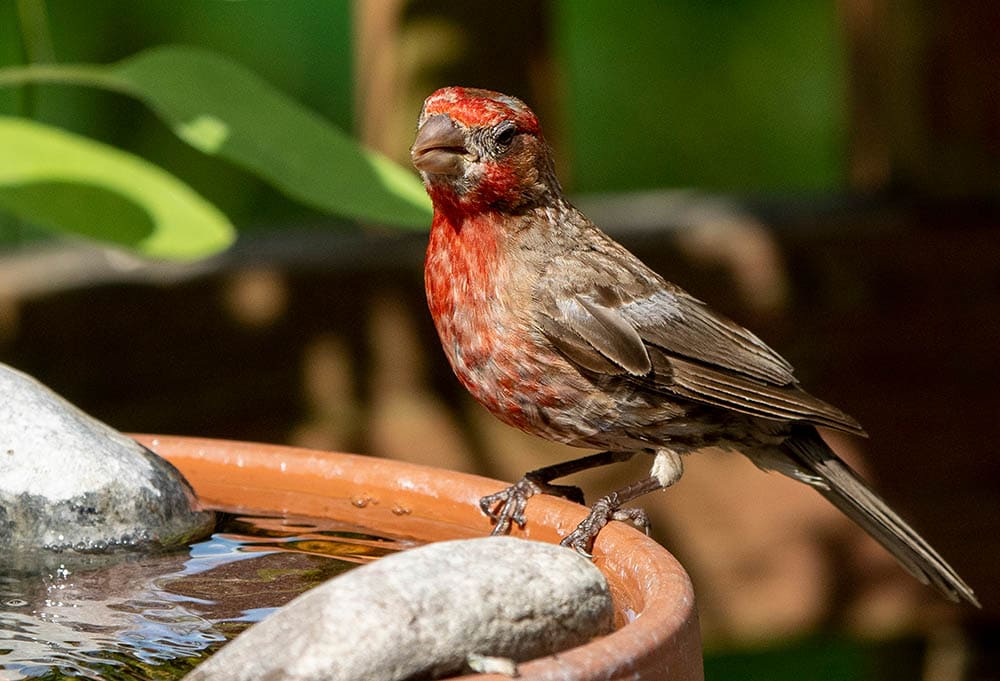
| Scientific Name: | Haemorhous mexicanus |
| Weight: | 6-0.9 oz |
The House Finch is more invasive to the eastern areas of the United States, but it is also commonly found in the Midwest and more specifically, in Iowa. You may often see them show up in large groups or pairs at your backyard feeder.
The males have brown-streaked feathers with red on their chest and head. The female house finches have all-brown feathers with hints of red along their necks and head. They’re adaptable to color conditions and may not migrate for the winter. They will eat at feeders and love to munch on seeds and nuts.
4. Mourning Dove
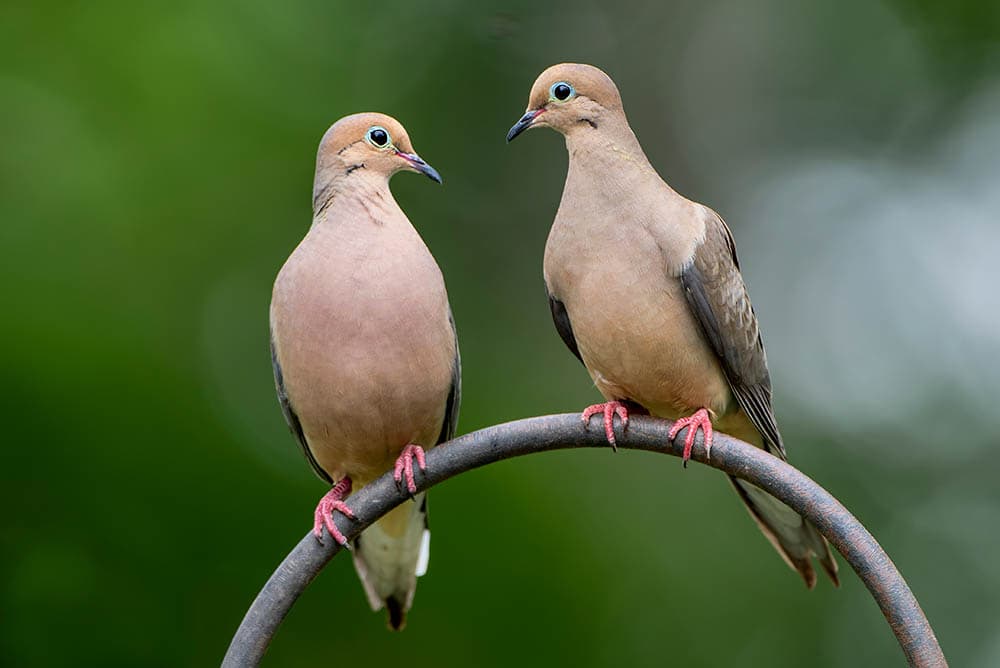
| Scientific Name: | Zenaida macroura |
| Weight: | 0-6.0 oz |
These puffy birds resemble robins, and you can also find them perched on telephone lines or on tree branches. They are easy to identify with their spotted gray bags and pale peachy under feathers. Mourning Doves have bright pink legs and black short beaks. You may see these birds in Iowa all year round and you can attract them to your backyard using a simple feeder with nuts or mixed seed blends. It also helps to scatter a few seeds in the grass.
5. Cardinal
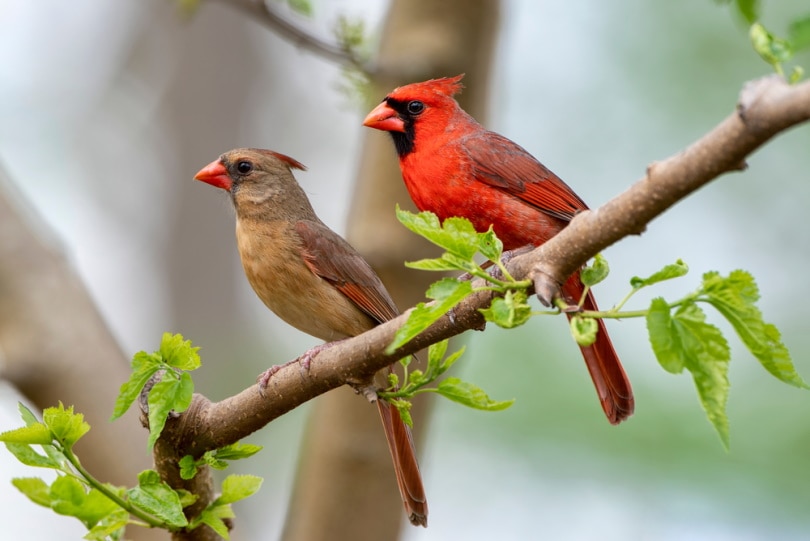
| Scientific Name: | Cardinalis cardinalis |
| Weight: | 5-1.7 oz |
The Northern Cardinal is one of the most common and easily recognizable backyard birds in the US. They’re common to the Midwest as well as the southwestern states. These birds have bright red feathers and a tuft hood that stands out from other varieties.
Both females and males have reddish-orange beaks and black feathers around their eyes. You may find these birds in Iowa all throughout the year and they are known to snack on black sunflower seeds and other mixed seed blends.
6. American Robin
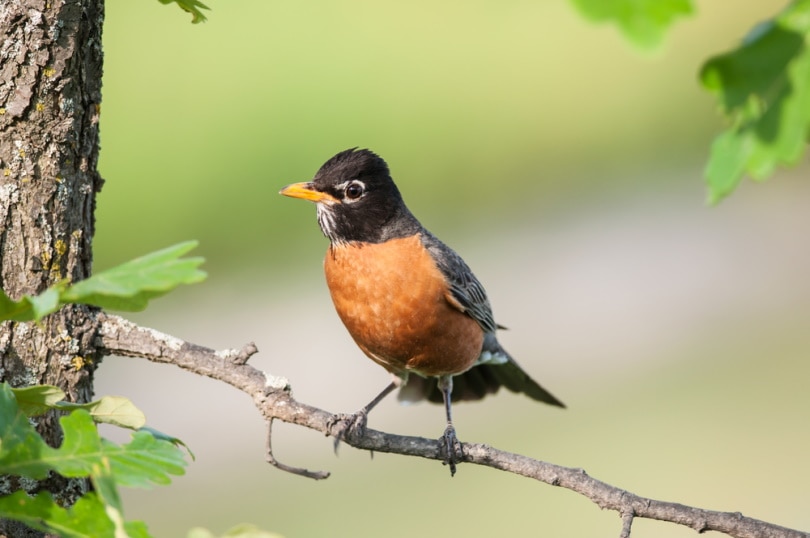
| Scientific Name: | Turdus migratorius |
| Weight: | 7-3.0 oz |
The American Robin is known for its orange underbelly in addition to its gray head and back. These small birds have round bellies, and they can be found in the state of Iowa all throughout the year. They love to feast on worms and small insects.
You’ll find that these birds won’t eat seeds from your feeder unless they are desperate for food. So, you can attract these Robins with small fruit, bird baths, and mealworms.
7. European Starling
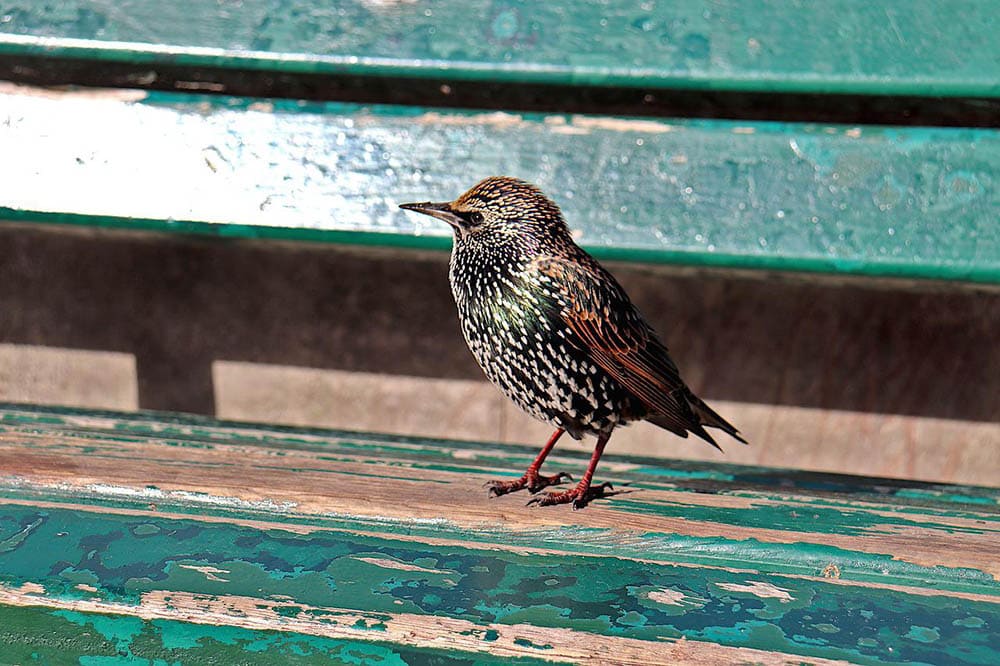
| Scientific Name: | Sturnus vulgaris |
| Weight: | 1-3.4 oz |
The European Starling was released into the wild in the 19th century and has grown in population ever since. They have dark gray feathers with noticeable white spots on their wings and backs.
Their yellow beaks and feet help them stand out from other similar varieties. Sometimes that starlings can have an iridescent green and purplish hue, which can make them quite remarkable to look at in the sunlight.
These particular birds are popular for killing their young, destroying the nest of other birds, and overtaking over nests, so you may want to think twice about feeding them if you notice them in your backyard.
8. Blue Jay
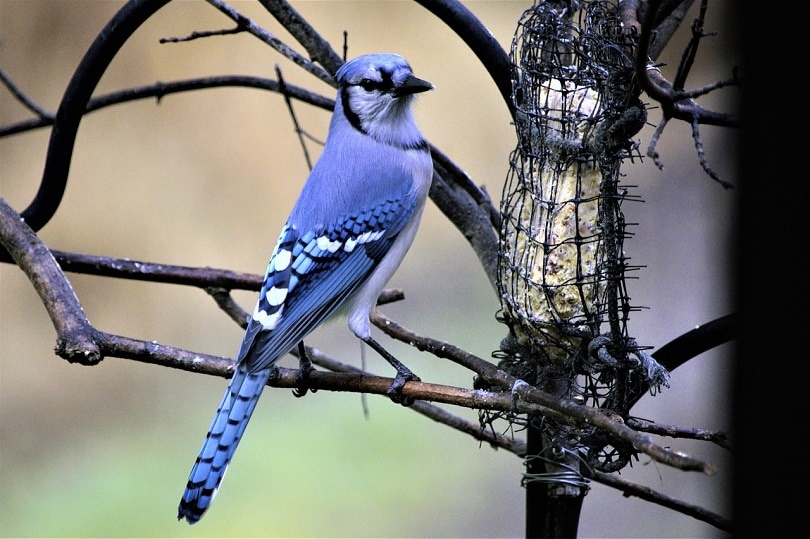
| Scientific Name: | Cyanocitta cristata |
| Weight: | 5-3.5 oz |
The Blue Jay is probably one of the most easily recognizable birds in North America. They are known for their striking blue feathers and a bright blue crest. Blue Jays have blue and white feathers on their backs and wings as well as their belly and chest.
Their tails may have black or blue stripes and a black ring around their neck which resembles a necklace. The loud mating call of Blue Jays makes them especially susceptible to predation by hawks and eagles. They love feeding at backyard feeders and enjoy nuts and mixed seeds.
9. Chipping Sparrow
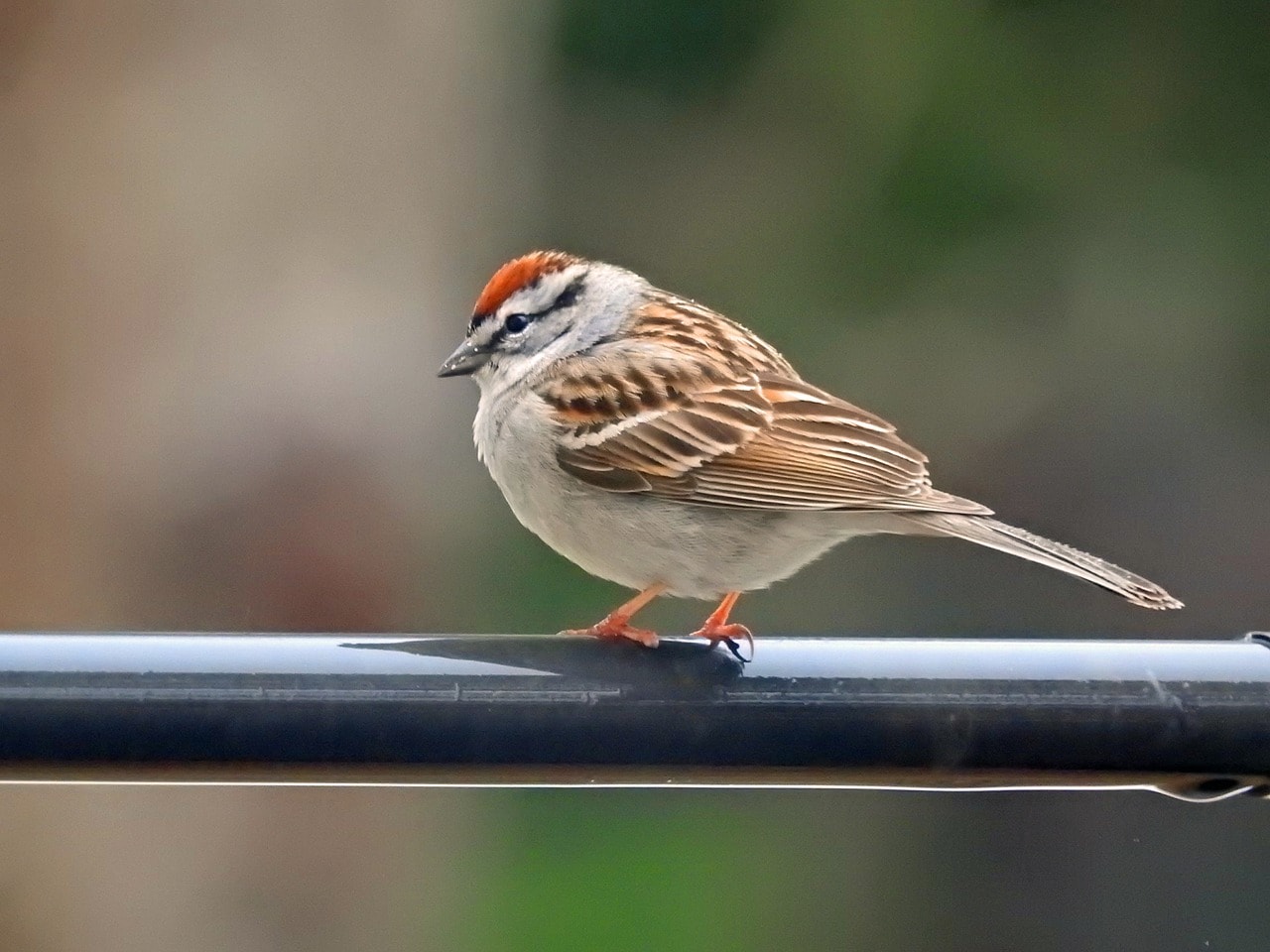
| Scientific Name: | Spizella passerina |
| Weight: | 4-0.6 oz |
The Chipping Sparrow has tan and brown striped wings with a puffy gray breast area. They also have a tannish red cap and black lines around their eyes. Their color may change slightly in the winter months and appear a bit darker.
You will see these birds during the spring and summer times, as they commonly migrate to the south for the winter. These are very common backyard birds, and you may often see them having at any worms, small insects, or nuts found on the ground.
10. Barn Swallow

| Scientific Name: | Hirundo rustica |
| Weight: | 6-0.7 oz |
Barn Swallows prefer open fields and plains, swampy marshes, and wetlands, as opposed to shady or wood areas. They have long fork-like tails and are very agile flyers. They have striking royal blue backs and heads, with wide or gray underbellies.
They almost look like a small Phoenix when they fully expand their wings. You can find them all throughout Iowa during the spring and summer months. Barn Swallows love to eat flying insects as well as different types of seeds. You may not find them often at feeders unless there is readily available food on the ground.
11. Gray Catbird
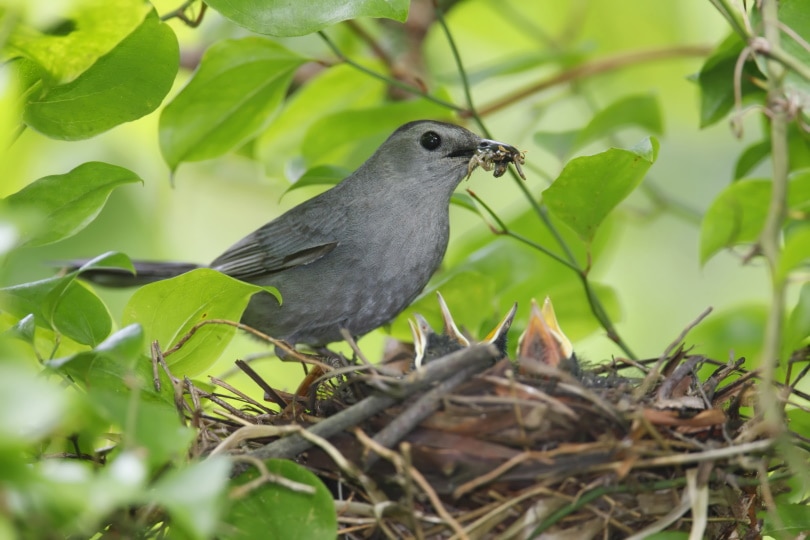
| Scientific Name: | Dumetella carolinensis |
| Weight: | 8-2.0 oz |
Catbirds almost resemble Robins in size and shape. They get their name from their distinctive and loud mating call, which resembles that of a cat’s “meow”. The catbird has dark and gray feathers and a black cap on top of their heads.
Their tale is long and dark and they have a rusty pan patch beneath it. You may find them hiding out in bushes and low-level trees, making nests, and hiding from predators. They are commonly seen in Iowa during the warmer months of the year and you can easily attract them with nuts, fruit, and various seeds.
12. Brown-Headed Cowbird
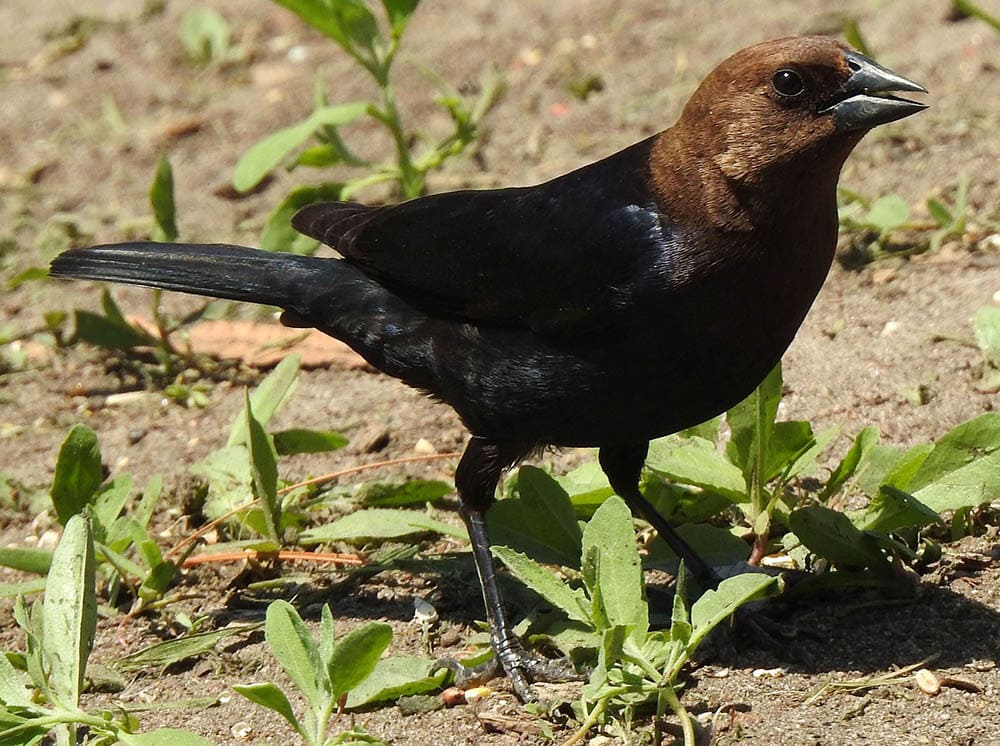
| Scientific Name: | Molothrus ater |
| Weight: | 5 – 1.8 oz |
Though these birds are typically thrown into the “blackbird” variety, they actually have brown feathers with dark brown heads. The females will usually have a lighter tone than the males. These are medium-sized birds with small sharp beaks.
They’re known for laying their eggs inside the nest of other birds, and they will often raise other birds as their own. They’ll remain in Iowa all year round if the weather is moderate during the winter. The cowbird is known for eating various types of seeds as well as some small insects.
13. Red-Winged Blackbird

| Scientific Name: | Agelaius phoeniceus |
| Weight: | 1-2.7 oz |
The females of this variety look very different from their male counterparts, with streaked dark brown feathers. The male blackbirds have beautiful black feathers and yellow and red shoulders that make them stand out.
Females are polygynous it may have up to 13 to 16 different females with which they are mating. These birds travel in large groups at times and can slowly overwhelm your feeder, so welcome them with caution. They love suet and various types of seeds.
14. Dark-Eyed Junco

| Scientific Name: | Junco hyemalis |
| Weight: | 6-1.1 oz |
The Junco is commonly thought of as a winter bird, but they can be found all over the US. They are small, puffy birds with dark gray feathers on their backs and heads. They have white feathers on their underbellies and their round bodies are great for laying on top of eggs. You’ll usually find these birds in wooded areas and forests.
They have black-lined pink pale beaks and short skinny legs. You may also catch them hanging out in your bird feeder (but more feeding from food on the ground), snacking on seeds, small insects, and nuts.
15. House Sparrows

| Scientific Name: | Passer domesticus |
| Weight: | 9-1.1 oz |
One of the most commonly seen birds in Iowa is the everyday House Sparrow. They have mostly brown feathers with small black or brown spots and streaks on their chests and wings.
The sparrow also has a small puffy build and is known for its aggressive behavior toward potential predators and other birds. These birds can be invasive, so you may want to think twice about placing a feeder in your backyard. They will eat almost anything and may be hard to get rid of.
16. Downy Woodpecker
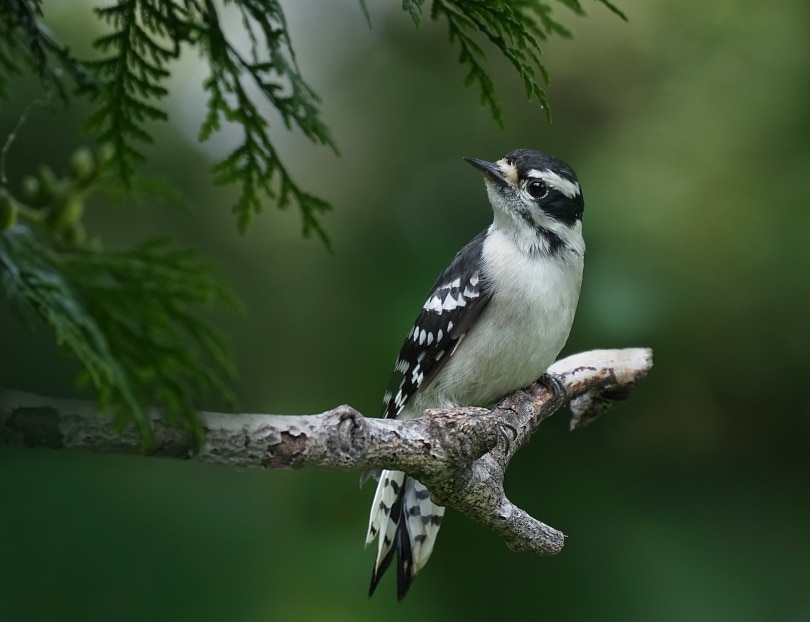
| Scientific Name: | Picoides pubescens |
| Weight: | 7-1.0 oz |
The Downy Woodpecker is a bird lover’s favorite. They’re one of the smallest varieties in the woodpecker family and are easily identifiable. These woodpeckers have white underbellies and black wings with white spots.
Their head has black and white stripes and the males have a patch of red on the top toward the back. They are smaller than the hairy woodpecker and migrate to the south for the winter. They commonly eat suet, sunflower seeds, and small nuts.
17. American Goldfinch
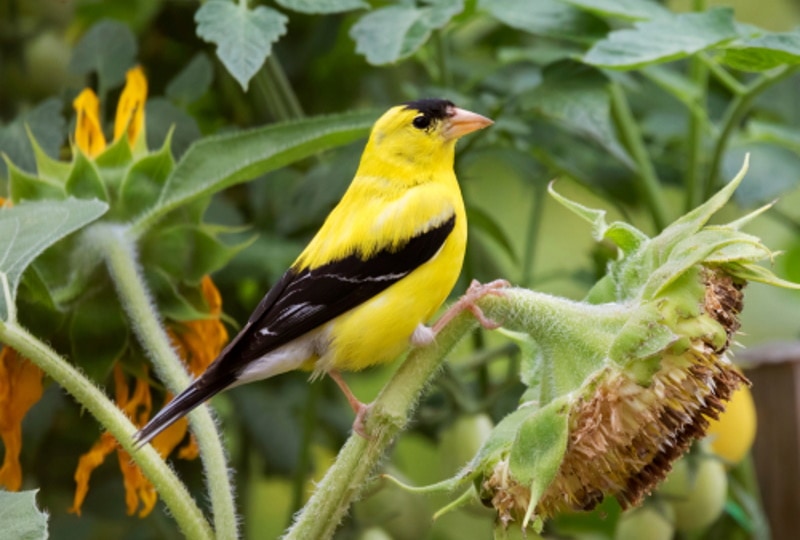
| Scientific Name: | Spinus tristis |
| Weight: | 4-0.7 oz |
The American Goldfinch is popular in Iowa and other Midwest states. During the winter months, they have an olive-brownish tone. But this quickly changes to a gold or a yellowish tone once they shed their feathers in the springtime.
They have black-tipped wings and a black cap. Their beaks are small, and they have short pink legs. You may find them around Iowa’s open plains or in large backyards and they are known for eating seeds and nuts.
18. Yellowthroat Warbler

| Scientific Name: | Geothlypis trichas |
| Weight: | 3-.04 oz |
The Yellowthroat Warbler is probably the most common of this variety that’s seen in the state of Iowa. They typically only spend their breeding season in the state and will usually migrate south for the colder months. The females have brownish-olive feathers with a black face and a canary-yellow throat.
The males look the same except they don’t have black masks. These birds hang out in brushy plains and fields or wet marshes and swamp areas. They aren’t likely to visit bird feeders, but they are known for eating small insects and dense vegetation.
19. Common Grackle
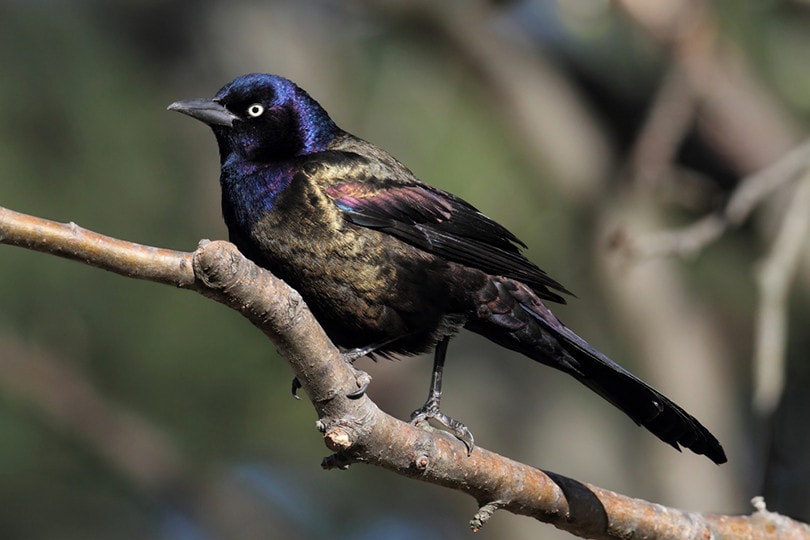
| Scientific Name: | Quiscalus quiscula |
| Weight: | 6-5.0 oz |
The Common Grackle is known to be a bit of a bully. It has light-colored, almost iridescent feathers and often appears black in certain light settings. This bird sometimes hangs out with other birds, such as blackbirds, and is known for traveling in large flocks.
They have a narrow body and long tail with yellow-ringed eyes. These birds are true foragers and will snack on just about anything. They’re commonly seen around Iowa with lands and open plains and are common year-round. For mealtime, the grackle loves small pests, insects, seeds, and fruit.
20. Northern Flicker
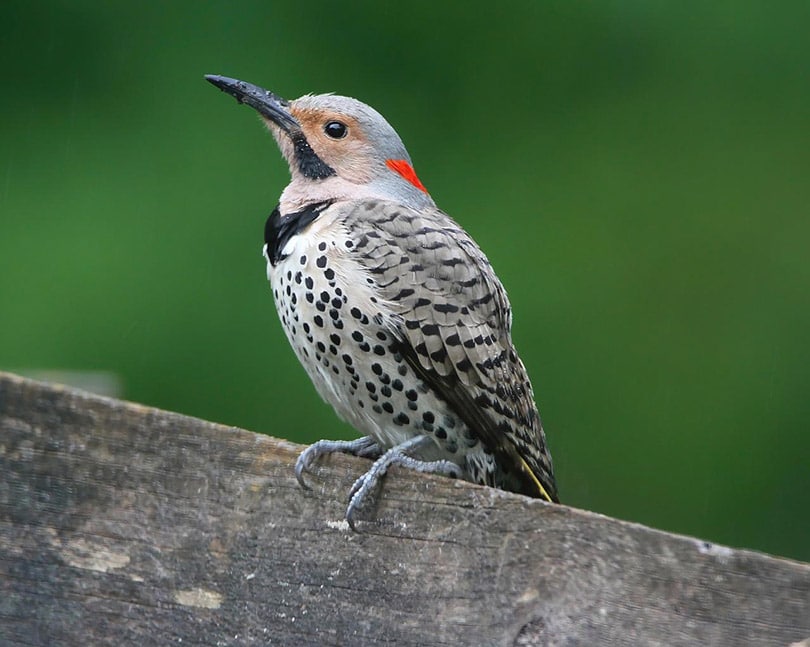
| Scientific Name: | Colaptes auratus |
| Weight: | 9-5.6 oz |
The Northern Flicker is very similar in appearance to other woodpecker varieties, except it has a red patch of feathers along both sides of its cheeks. Over their bodies, they have light gray feathers, with small black spots.
They also have a small patch of tan-orangish feathers beneath the bottom of their tail. These flickers have a wide wingspan and can be found in Iowa all throughout the year. For food, they prefer suet, ants, beets, nuts, and seeds.
21. Red-Bellied Woodpecker

| Scientific Name: | Melanerpes carolinus |
| Weight: | 0-3.2 oz |
This medium-sized bird is known for its beautiful redhead and zigzagging black and white feathers. They have white underbellies, which make for a great contrast to their dark back feathers. The Red-bellied Woodpecker has skinny legs, and you will find them around Iowa all year round. They love suet, and will also eat peanut butter, millet, and other nuts and seeds.
22. Hairy Woodpecker
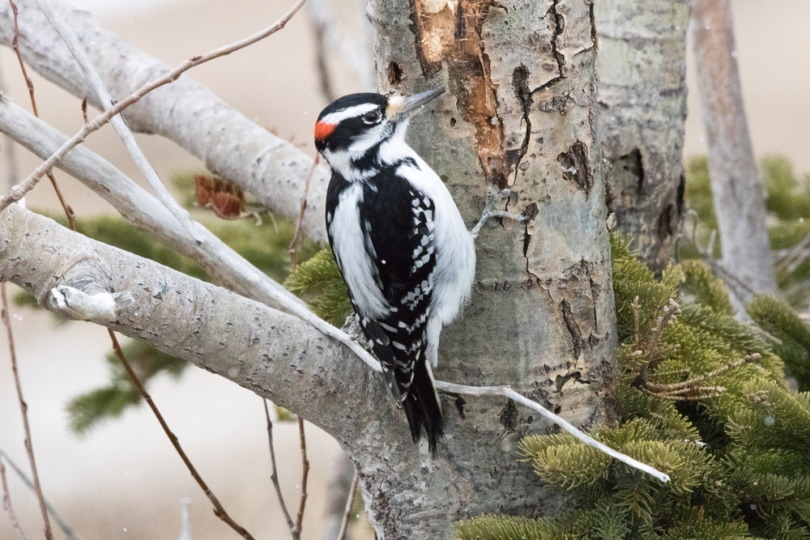
| Scientific Name: | Leuconotopicus villosus |
| Weight: | 4-3.4 oz |
The Hairy Woodpecker is smaller than other woodpeckers but is similar in color. They have a long beak and black and white striped feathers along with their head and back. You can find these wood packets around Iowa marshlands and open plains all throughout the year.
Similar to other woodpeckers they have a red patch right at the top of their head and they love to feed on seeds, suet, and fruit. You may also catch them eating small insects and berries.
23. White-Breasted Nuthatch

| Scientific Name: | Sitta carolinensis |
| Weight: | 6-1.1 oz |
These birds are very common to backyard feeders, and you can also see them and trees along the road. They love hanging out in the open grassy areas where they can walk freely to scout for food. The nuthatch has a sharp beak, black and gray wings, and a whitish underbelly.
These small birds are known for the thick black stripe on their hood and commonly store seeds within the bark of trees. They may migrate to the south for the winter, or they may stay, depending on weather conditions. They are known for eating sunflower seeds, insects, peanuts, and other seeds.
24. Baltimore Oriole
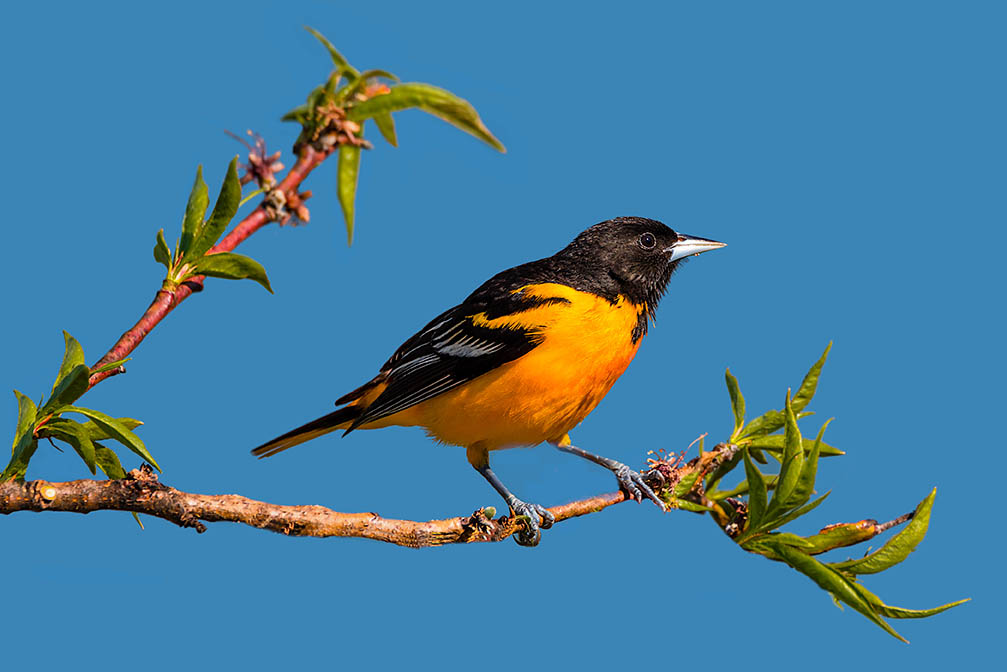
| Scientific Name: | Icterus galbula |
| Weight: | 1-1.4 oz |
The oriole has a small stature with a puffy chest and small, short legs. They have black feathers on their back and heads, with some gray beneath their tales. And had their bellies have a brilliantly orange-yellow hue.
The coloring on the females may vary a bit, with lighter orange bellies, and lighter wings. They are migratory birds and will usually show up in Iowa and surrounding states in the spring and summer months. They feed on fruit rinds (such as orange peels), nuts, and various seeds.
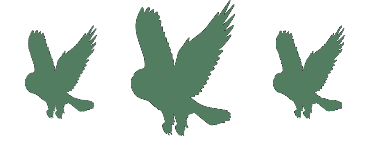
Conclusion
So, as you can see, the state of Iowa is full of quite a few different bird species, and there are more to explore. If you’re looking to do a bit of bird watching, be sure to add a feeder to your backyard and fill it up with food including suet, sunflower seeds, peanuts, and any foraged fruit that you may find. Within as little as a matter of minutes, you may find some of these birds flocking to your backyard to fill their bellies.
See Also:
Featured Image Credit: Carrie Dugovic, Pixabay
Table of Contents
- Common Backyard Birds in Iowa
- 1. Black-Capped Chickadee
- 2. Song Sparrow
- 3. House Finch
- 4. Mourning Dove
- 5. Cardinal
- 6. American Robin
- 7. European Starling
- 8. Blue Jay
- 9. Chipping Sparrow
- 10. Barn Swallow
- 11. Gray Catbird
- 12. Brown-Headed Cowbird
- 13. Red-Winged Blackbird
- 14. Dark-Eyed Junco
- 15. House Sparrows
- 16. Downy Woodpecker
- 17. American Goldfinch
- 18. Yellowthroat Warbler
- 19. Common Grackle
- 20. Northern Flicker
- 21. Red-Bellied Woodpecker
- 22. Hairy Woodpecker
- 23. White-Breasted Nuthatch
- 24. Baltimore Oriole
- Conclusion
About the Author Robert Sparks
Robert’s obsession with all things optical started early in life, when his optician father would bring home prototypes for Robert to play with. Nowadays, Robert is dedicated to helping others find the right optics for their needs. His hobbies include astronomy, astrophysics, and model building. Originally from Newark, NJ, he resides in Santa Fe, New Mexico, where the nighttime skies are filled with glittering stars.
Related Articles:
Monocular vs Telescope: Differences Explained (With Pictures)
10 Types of Hummingbirds in Arkansas (With Pictures)
8 Types of Hummingbirds in Nebraska (With Pictures)
5 Types of Hummingbirds in Idaho (With Pictures)
3 Types of Hummingbirds in Mississippi (With Pictures)
8 Types of Hummingbirds in Kansas (With Pictures)
5 Types of Hummingbirds in West Virginia (With Pictures)
5 Types of Hummingbirds in Ohio (With Pictures)
